I’m kind of on a soundtrack and score bender. I previously wrote about heroic themes. From Captain America to Star Wars to Indiana Jones, heroic fanfares are a staple of the movie experience; however, without a good antagonist, our heroes wouldn’t need to exist. Villain themes can be just as interesting and engaging as heroic themes, and every bit as blatant or subtle. Like with heroic themes, a good villain theme reflects the complexity or simplicity of the character, entity, or event. It’s probably a little bit of a misnomer to refer to them as “villain” themes, but that is the term I feel lends more symmetry to the “heroes and villains” dichotomy, so I will divide up villainous themes into Individual Antagonists, Beasties, and Events as Antagonist. But first, a little background.
I was a music nerd all though school. I played violin, sang in the choir, and played mallet instruments like the xylophone and marimba in the pit percussion section of the marching band. Even before that, I was exposed to different types of music from an early age by my parents, whose tastes run from classical to rock to country to Broadway. They wanted to make sure that my brother and I had some classical music competency, so they invested in a record (yeah, we were a weird vinyl family) of Sergei Prokofiev’s Peter and the Wolf when we were little enough to not even be in school yet.
The story is meant to introduce young children to orchestral music, and each character’s leitmotif is represented by a particular instrument. Peter, the young hero, is signaled with violins. Sonia the duck is an oboe, and the cat is a clarinet. The Wolf? The antagonist of the story’s theme is played by French horns.
Really scary French horns that SOUND like stalking innocent children and waterfowl through the forest. I swear, this wolf has got to be related to the Big Bad Wolf that ate Red Riding Hood and her grandmother, right?
As the older sibling by two years, I should have been the one doing the traumatizing, but my brother figured out that I was freaking terrified of the Wolf’s theme and started using it to mess with me. He would pretend to be the wolf, and darned if that kid couldn’t have won an Oscar. He was convincing, and I had an overactive imagination (still do—whenever I hear a bump in the night, I assume monsters and closet squatters and pull the blankets over my head), and I did make fun of him for crying over sad movies, so I guess I kind of had it coming. That music STILL gives me the creeps, and it is the foundation on which I built my appreciation for a good villain theme. Years later, that theme can still convince me that if I put my feet down from the couch, I’ll be pulled under and mauled by a wolf. Couchwolves are a real problem. Don’t judge me.
Also instrumental (pun totally intended) in shaping my appreciation of a good antagonist theme was the Mars: Bringer of War track from Holst’s The Planets. I feel like this track may have influenced many composers, especially parts of John Williams’ Star Wars scores. This, and such crossover classical pieces as Mussorgsky’s Night on Bald Mountain, featured in Disney’s Fantasia, in an animated short designed to give children nightmares, sparked my interest in the crafting of a good villain theme.
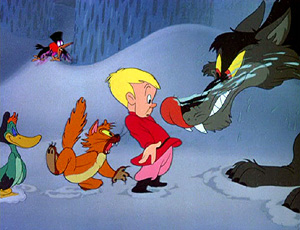
This won’t screw me up at all. I’ll be fine, and never have weird dreams about being chased by wolves while French horns bray in the background …
Individual Antagonists:
An individual antagonist is usually set up in direct opposition to the position of the hero(es). The Darth Vader to your Luke and Leia. The Catwoman to your Batman. The Magneto to your X-Men. The Saruman to your Gandalf, etc. And sometimes, of course, Gandalf and Magneto are the same guy, which is both wonderful and confusing. Thank you, Sir Ian McKellen!
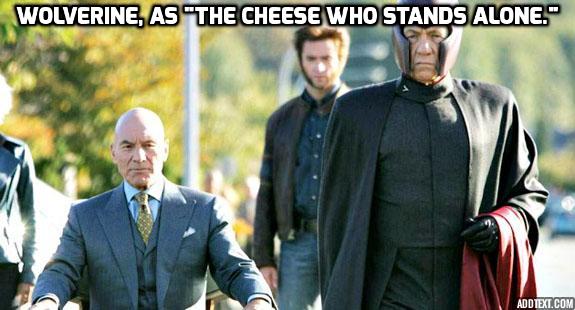
Third Wheel Wolverine is always tagging along with Prof. X and Magneto.
1.) Darth Vader/Anakin Skywalker –
After Peter and the Wolf, Star Wars was my first real playground for understanding soundtracks. “The Imperial March,” while technically representative of The Galactic Empire as a whole, is really most closely tied to the character of Darth Vader. As if to cement this, composer John Williams reached into the past/future (depending on how you look at it) to set up that association when he did the Phantom Menace soundtrack. The gentle, sweet theme song for young Anakin Skywalker contains the Imperial March. Listen at the 1:55 mark, and you will hear it. This retroactive foreshadowing is the kind of attention to detail that I appreciate the most when a composer takes on a series of movies, and it is the element that I find I wish had been taken into consideration more with the Marvel Cinematic Universe.
Not that there isn’t some amazing music, but what if … what if Natasha’s Theme was the same from Iron Man to Avengers and onward? What if the same kind of consistency had occurred with the motifs that represent each character? I think that would have elevated the entire experience from its already high standard into the stratosphere of fantastic-ness. I’m just happy they kept the Avengers theme itself in both movies so far! Back to Vader and Kid Vader—burying hints of The Imperial March in Anakin’s Theme is a musical metaphor in action, implying that the seeds of darkness that enabled the transformation from sweet kid to genocidal maniac were there all along.
The circle is completed with the Darth Vader’s Death track from The Return of the Jedi. Listen at 0.49, when The Imperial March is softly played on strings, and again at 2.06, when it is softly plucked on a harp. I have very, very high hopes for the soundtracks for the new Star Wars movies, and I hope that they continue with their long track record of attention to detail. It could open up a whole new generation to the world of soundtrack appreciation, and I hope that it does!
2.) Saruman/Isengard –
Saruman’s theme by Howard Shore is synonymous with the defiled Isengard. Even before he started his orc-farming business working for the Angry Eyeball on a Stalk, Saruman the White and the stronghold of Isengard were linked. The first notes convey a sense of foreboding, and the bombastic percussion that begins around 0.45 calls to mind the Uruk Hai and their violence and destruction. Sir Christopher Lee was magnificent as the once-good, corrupted Saruman.
His entire character brings to mind the famous Nietzsche quote, “He who fights with monsters should look to it that he himself does not become a monster. And when you gaze long into an abyss the abyss also gazes into you.” Saruman was once a good man, but he gazed too long into the abyss (possibly literally, using the palantir) of Sauron and became himself corrupted. The low brass is threatening and combined with the percussion, it becomes a war cry.
Check out this scene where his theme plays as he turns the once-virtuous Voice of Saruman to an evil task, and let me know what you think!
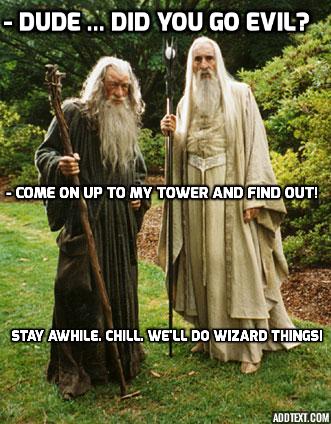
Wizard things!
3.) Catwoman from Batman Returns –
Danny’s Elfman’s theme for Selina Kyle reflects her transformation. It starts out soft and confused, like Selina’s muddled emotions, and crescendos into a mad, spiraling motif that reflects her mental state. My favorite part is at 2:32, where the theme changes from mewing string licks into a fully orchestrated motif. Like many of the best “villains” Selina Kyle’s story is complicated. Her Batman Returns incarnation was a secretary who knew too much, and was thrown off of a rooftop.
She survives the fall and staggers back home, where she destroys all of the hallmarks of her previous life and value system—she puts her stuffed animals down the garbage disposal (Noooo! Anthropomorphic Me freaked out at that part!), defaces and destroys her cute, girly things, and sews her Catwoman costume herself in preparation for her new life as a vigilante and thief. It’s a really good Making-of-a-Hero-or-Villain scene, and the theme that plays while she is having her breakdown and rebirth reflects her sadness, madness, and determination. This Catwoman walks the line between justice and darkness, just like Batman, but comes out a little short of change on the side of the moral cash register. She illustrates just how thin the line is when vigilante justice is on the menu, and how easy it is to be driven over that line.
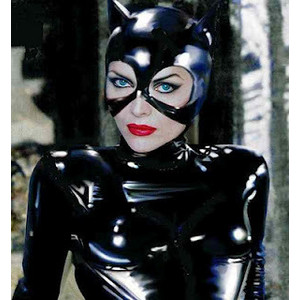
Fell off of a building. Walked home and made a costume. Badass.
4. Don Karnage and the Iron Vulture from TaleSpin – Christopher L. Stone scored the Disney Afternoon cartoon show like an adventure film. Characters have their own themes and motifs are woven together to reflect the narrative in the score. On top of the 1930’s-1940’s adventure vibe to the soundtrack as a whole, Stone created one of the most fun, over-the-top villain themes I’ve ever heard.
Everything about the character of Don Karnage is ridiculous. He mixes his metaphors, he has an accent that doesn’t seem to come from any one place. And … he’s also a cartoon wolf/coyote/dingo person. All of that said, have a listen to this at the 0.48 mark and tell me it’s not pretty cool. The track title is, “Wind Surfing, Iron Vulture.” The Iron Vulture is an enormous airship/aircraft carrier that is the flying base of Don Karnage and his air pirates. Like Captain Jack Sparrow, Don Karnage has two different theme songs that reflect different aspects of his personality.
The goofy side of Don “Do not shoot at Will—he is my second mate!” Karnage is represented in the tracked titled, “Don Karnage’s Theme.”
His more serious and dangerous side shows through in the Iron Vulture track. The beauty of his character is that he’s both goofy and legitimately dangerous—after all, he did manage to steal the Iron Vulture from somewhere, right? And, he’s just kooky enough that you never know which Don Karnage you’re going to get. As he says, “My door is always open, sometimes.”
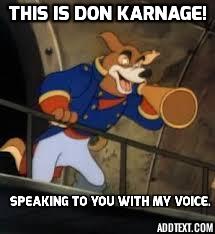
Yes, no?
5.) Davy Jones –
Hans Zimmer’s theme for the cursed pirate Davy Jones from the Pirates of the Caribbean franchise is as tragic and fierce as his character. The track starts with the motif played slowly on a music box, representing Davy Jones’ lost and twisted love for Tia Dalma, and ends up a faster version of itself played on an organ by Davy Jones himself! That’s right—this villain is so cool that he played his own theme song in the actual movie, and no one blinked an eye.
He’s like, “Okay, this is the sound of my frustration, anger, and octopus-ed face. Listen to me pound this organ, bitches!” And his crew are probably all like, “Okay, the Captain’s giving a concert of pain again. He only does this when we surface, because water, so everyone at least pretend you like it, okay?” His angry theme and his love theme are the same, because … well, because love and anger are related. If he didn’t still have feelings for her, he wouldn’t have been mad enough to go listen to his music box, get sad, and take out his frustrations on a musical instrument. When a composer can make the soundtrack reflect the inner workings of a character like this, take the things that make them an individual and give them voice with music, the genius of good soundtrack composition is truly revealed.
6.) Magneto –
The Magneto theme from X-Men: First Class, by Henry Jackman manages to sound like metal, and like purposeful striding, which are two things Magneto is pretty good at. Just picture Michael Fassbender striding around in his Magneto suit, bending metal like he’s Toph from Avatar the Last Airbender on speed. And then, picture him growing old and looking like Gandalf. Pretty cool, huh? Yeah, that’s Magneto. One of the best things about his character is how very convinced of how right he is. He’s not a villain in his own mind; he’s the hero.
7.) Sephiroth –
Nobuo Uematsu’s theme for the main villain in Final Fantasy 7 is everything I want from a villain song—Screaming Latin Chorus actually saying my name as I villain about? Check! Percussive orchestral hits? Check! Pretty section? Check! I may prefer Kefka as a villain, but I’ve written about Dancing Mad and how much I love it more than a few times now, and I also love the Sephiroth theme. Admittedly, if I chose to villain up, “Sara Goodwin” shouted by a Screaming Latin Chorus would not be anywhere near as cool as “Sephiroth!” You have to have the right kind of name to villain properly—ask Tom Marvolo Riddle, who had the good sense to change it up to Voldemort.
Beasties:
1.) The Kraken –
The original Beastie from Pirates of the Caribbean: Dead Man’s Chest has a fast-paced and menacing theme that (not surprisingly) features the braying of French horns around the 3:30 mark. I’m telling you, they’re the instruments of terror. My actual favorite part of the Kraken theme is the buildup that starts around the 1:30 mark and turns into a pipe organ-heavy version that is reminiscent of Davy Jones’ penchant for playing the pipe organ. He even plays the organ sadly after the Kraken has been killed, implying that he had some measure of affection for the creature. At the very end of the track, you can hear the thump-thump of percussion, meant to imitate the beat of Jones’ much-sought-after heart. Clever man, Mr. Zimmer!
2.) The Nazgul –
The Nazgul may once have been human, but not so much anymore. Their inhuman screams were some of the creepiest sounds I’ve ever heard in a movie. The discordant nature of the brass before the unholy chorus of the damned start singing in the background during the chase scenes. The unrelenting bass line in certain parts of the track is representative of the unrelenting nature of the Nazgul themselves—they will not stop hunting. Well, not without getting flushed down the river with Elvish water magic from a ring of power! I know it’s not in the books, but I still so love the part where Arwen stands there and dares the Nazgul, “If you want him, come and claim him!” The bass line I’m referring to can be heard around the 4:30 mark, and often accompanies the Nazgul onscreen.
3.) Jaws –
People actually attend viewings of Jaws held in public swimming pools for that extra layer of terror that horror fans like to experience. Personally, I can’t handle it. I scared myself on a vacation as a nine-year-old by thinking about sharks and closing my eyes in a hotel swimming pool. I was indoors. Nothing was going to happen. But that music and the associations it bears were enough to drive a nine-year-old girl to surface gasping in the pool, expecting her legs to get chewed off by a pool shark. Yeah, couchwolves and poolsharks are very dangerous beasties!
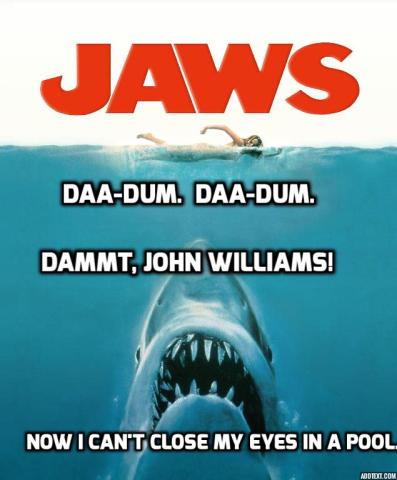
The music that keeps us from relaxing in water.
Events, Entities, and Such:
1.) The Birthday from GunxSword – The main antagonist in GunxSword is an unassuming old man known as The Claw. He is completely out of his mind and highly charismatic, and has, by the end of the series, set up a way to “save” the world—he will launch himself into space and disperse his will, infecting everyone with himself and his vision for the future. He’s basically trying to eliminate free will for the greater good, and he truly believes that he’s right. He calls the event The Birthday, and even has a shiny new “birthday suit” (yeah, I know) to wear for the event. His suit is a protective armor shield, but still. This track sounds like a prospersous future, like goodwill and happiness, but what he’s about to do will erase individual will. He’s so very wrong, but he’s also so pleasant and happy to die for everyone else’s wellbeing … the madness of the character and the event are captured well in this track.
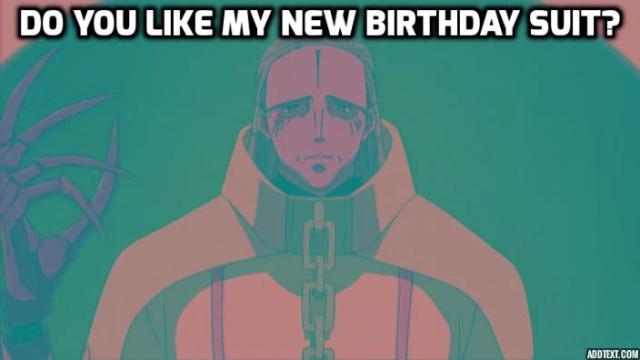
Hi! I’m a mad old man who flew the freaking moon!
2.) Ra and his Procession from Stargate –
Ra, the alien entity and his posse are inhabiting human bodies and wreaking a good bit of havoc, keeping the locals enslaved, etc. The choral theme that accompanies his attempted ascension at the end of the movie captures his menace well. This is a being capable of subjugating an entire people with his alien technology. The more dire things become, the more the chorus ramps up the chanting.
It works really well to clue the audience in to level of danger the characters are facing. David Arnold’s soundtrack is one of my favorites, and the Ra chant crops up in other tracks as well. While the theme represents Ra, it also doubles as a battle theme and stand-in for the other aliens as well. It’s more representative of the general threat to the protagonists than it is of the antagonist himself, and so I chose to categorize it under events and entities rather than individual antagonists.
3.) The Intro from The 7th Guest –
This video game has a really cool intro song that is far more representative of the house itself and its haunting than it is of any one person. The game was a puzzle solving mystery game, and contained several cut-scenes where parts of the storyline were acted out. It was up to the player to figure out not only the puzzles but also the plot. Composed by The Fat Man (that’s really his music name. I promise!), the soundtrack to The 7th Guest contained creepiness, horror, comedy, and a touch of rock.
I hope this article gives anyone interested in the darker side of soundtracks a decent starting point, and if you have a suggestion for something I should listen to, should have included, or am an idiot for not knowing about (kidding—I love you, The Internet!), please comment below or give me a Tweet!
Sara Goodwin has a B.A. in Classical Civilization and an M.A. in Library Science from Indiana University. Once she went on an archaeological dig and found awesome ancient stuff. Sara enjoys a smorgasbord of pan-nerd entertainment such as Renaissance faires, anime conventions, steampunk, and science fiction and fantasy conventions. In her free time, she writes things like fairy tale haiku, fantasy novels, and terrible poetry about being stalked by one-eyed opossums. In her other spare time, she sells nerdware as With a Grain of Salt Designs, Tweets, and Tumbls.
—Please make note of The Mary Sue’s general comment policy.—
Do you follow The Mary Sue on Twitter, Facebook, Tumblr, Pinterest, & Google +?



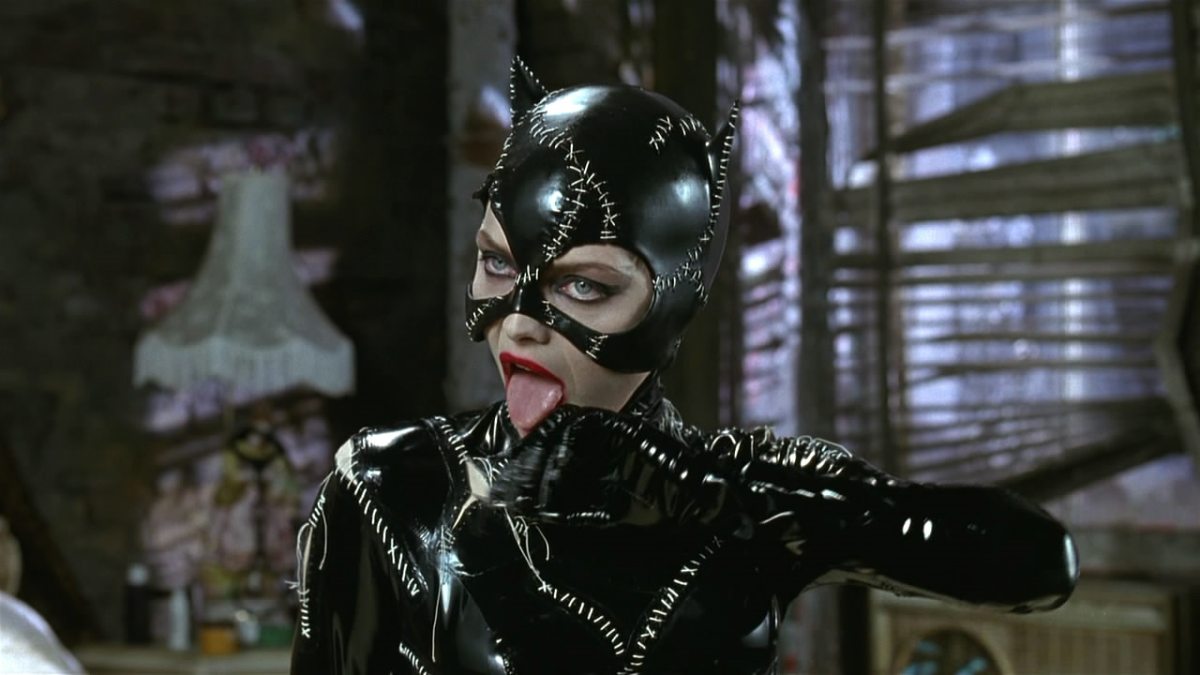
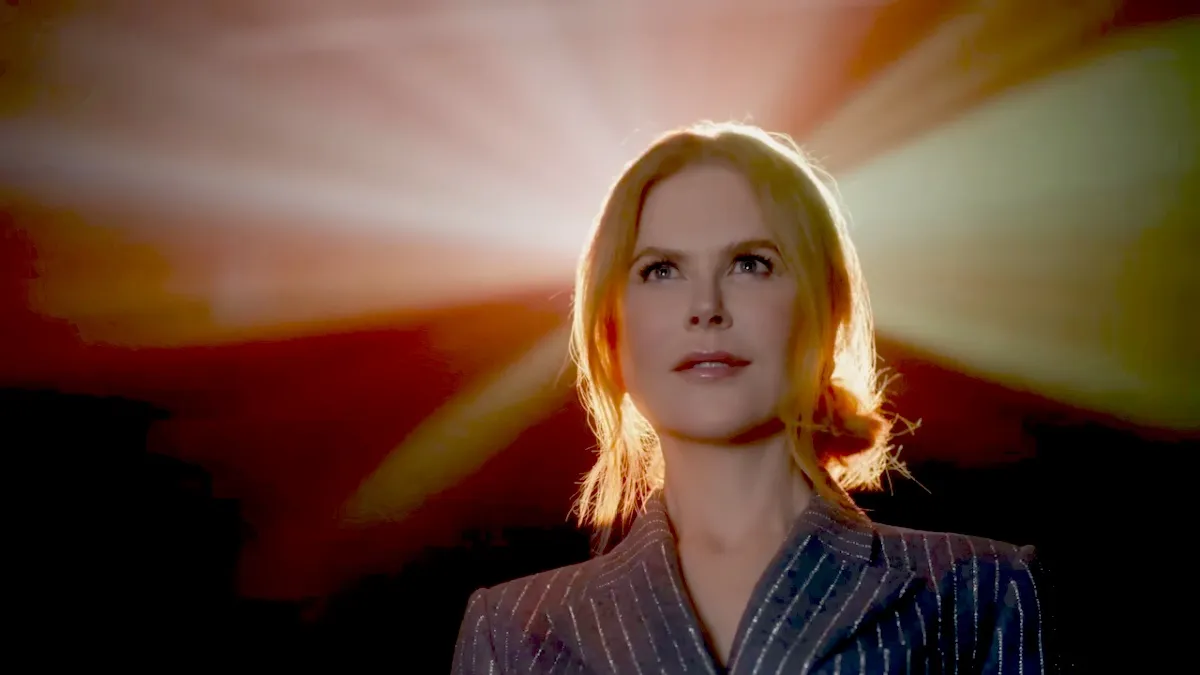




Published: Jul 10, 2015 12:55 pm